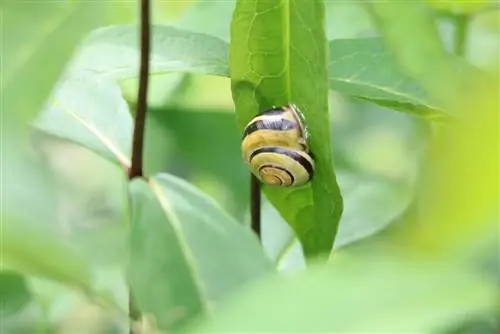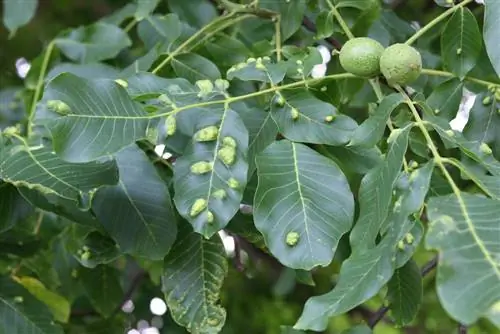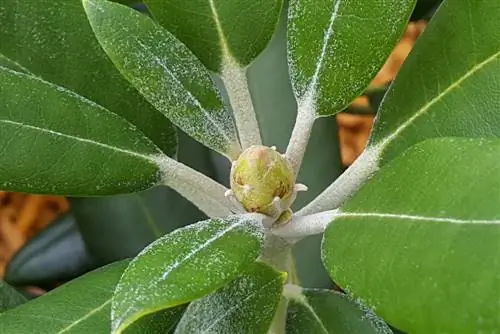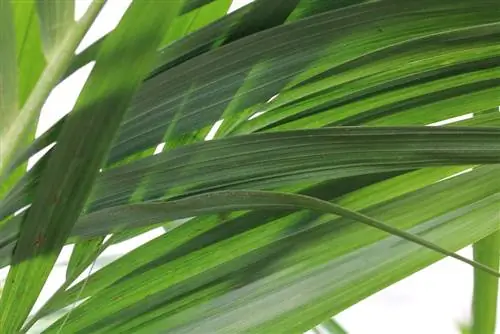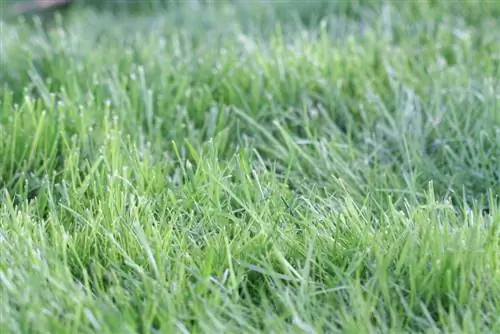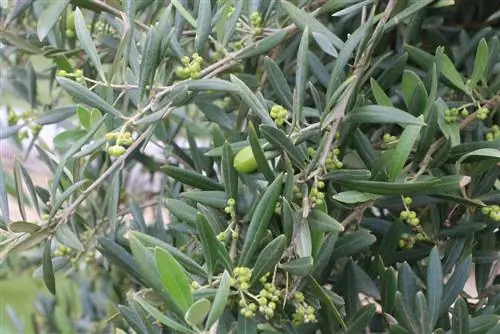- Author admin [email protected].
- Public 2023-12-17 03:39.
- Last modified 2025-01-24 12:45.
Pests can be found on weakened houseplants, especially in winter and spring. In the cold season, the plants have too little light and the warm, dry air from the heating creates an unfavorable climate. This changes the composition of the plant sap. If the plants are also over-fertilized with nitrogen, this offers favorable conditions for pests to multiply quickly. In the garden, unfavorable locations or soil conditions are to blame for plants being attacked by pests. While mostly sucking insects cause mischief indoors, in the garden it is damage caused by feeding that causes problems for the plants.
Aphidoidea
Aphids are plant lice (Sternorrhyncha) and are found in Central Europe with an impressive 850 species. The most common are the green peach aphid and the black bean aphid. Aphids are small insects measuring just a few millimeters in size. All aphid species have forms with and without wings. Unwinged aphids are able to reproduce through juvenile breeding. If the population on a plant grows too much, a winged generation is formed that colonizes new host plants.
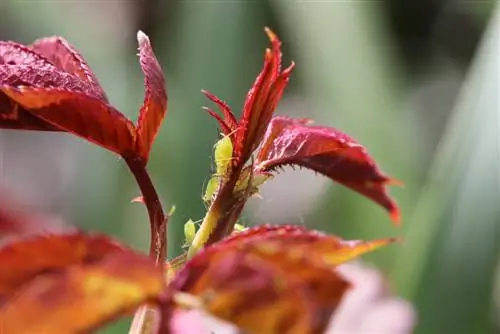
Aphids are mainly found in shaded areas on the underside of leaves or on the young shoot tips as well as near the bases of flowers or leaves. There they suck the juices out of the plant in large colonies, which leads to the shoots dying. An infestation is manifested by yellowed, curled leaves and stunted shoot tips. Furthermore, aphids excrete sticky honeydew, which can secondarily lead to the colonization of black fungus. Aphids are among the most important vectors of plant viruses. Practically all houseplants are attacked by aphids.
Tip:
Aphids are often introduced by other plants. Sometimes just an open window and a draft is enough. Where it is warm and dry, aphids feel particularly comfortable.
Otiorhynchus
Black weevils are brownish to black colored beetles about 10 mm in size. An infestation with black weevils can be recognized by the curved to semicircular feeding marks on the leaves from the end of May. Weevils are mainly active at dusk and at night and eat plant shoots, but this usually does not cause any major damage to the plant.
From July to September, the females lay their eggs in the ground, from which the white larvae, which are approximately 10 mm long, hatch. Black weevil larvae feed on the roots of the plant, causing it to die if the infestation is severe. Black weevils overwinter as both larvae and beetles.
Caterpillars
Butterflies and moths are very popular animals with most garden owners. But before they become the pretty butterflies, they first cause mischief as caterpillars. The cabbage white butterfly caterpillar is particularly feared because it prefers to eat the leaves of cabbage plants. The cabbage white caterpillar is about 4 cm long, has a yellow-gray-black mottled color and fine hairs. The diamondback moth caterpillar is also very common and is light green in color and about 1-2 cm long. The cabbage or gamma leg, which can grow up to 5 cm long and whose color varies between green and brown, is also a cabbage and vegetable pest.
Perforated or eaten leaves on vegetable plants, flowers or bushes indicate an infestation by caterpillars. In some cases, drill holes in cabbage plants can also be seen.
Scale insects (Coccoidea)
Scale insects belong to the plant lice family (Sternorrhyncha), of which around 90 species are known. Male scale insects are completely harmless to plants because the winged lice have no mouthparts and therefore do not eat. It's different with the female specimens. They usually live in larger colonies on different parts of plants. The species we find here are usually between 0.8 and 6 mm long and have a shield-shaped carapace in which the female scale insects are encapsulated.
Scale insects are difficult to recognize. You first notice them by their sticky secretions (honeydew), which shimmer as small droplets on the leaves or on the ground. They are often found on aralia, ficus, oleander, orchids and palm trees. But they also attack sclerophyll plants such as citrus plants or laurel.
Snails
Although there are a whole range of different species of snails in the garden, only the slugs are really dangerous for the plants (here especially the Spanish slug). Snails prefer to eat young plants, but can also eat larger plants (such as vegetables and perennials) completely bare overnight. Sometimes only the stem remains or the above-ground parts disappear completely.
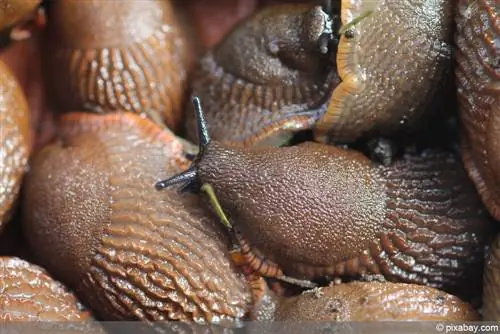
As early as February or March, the snails hatch from the eggs that have overwintered in the garden soil and go looking for food. Slugs are 10 cm long or larger and prefer to attack the fresh shoots of perennial plants or vegetable plants planted outdoors in the garden. Snails are hermaphrodites and lay between 200 and 400 eggs in the soil. If conditions are good, several generations are formed each year. During the day the snails hide in a shady, moist place and then become active at night.
Sitka spruce louse (Liosomaphis abietinum)
The Sitka spruce louse may look harmless, but it can cause a lot of damage. If there is an infestation, something must be done quickly against the lice, otherwise the conifers will slowly but permanently die. If entire branches or parts of coniferous trees slowly but surely turn brown, this can indicate an infestation with Sitka spruce lice.
Sitka spruce lice are not that easy to recognize. The best way to do this is to hold a sheet of white paper under an older branch and then tap the branch with a broom handle. The tiny green lice become visible on the paper. If more than five lice are visible, control should be carried out.
Spider mites (Tetranychidae)
The spider mites belong to the suborder Prostigmata of the mite family. Spider mites are sucking insects that can only suck plant sap from the epidermal cells of plants because they are only microscopic animals. Many of the spider mites have a reddish color and are usually only noticeable as tiny dots on the plant when they have already appeared in large numbers. They cover the undersides of the leaves with a fine web and suck out the leaf cells, creating a silvery, translucent dot pattern when viewed from above.
Sciaridae and Lycoria species)
The larvae of fungus gnats have the important task of decomposing plant residues and thus making their nutrients available to other plants. Therefore, fungus gnats should not necessarily be viewed as pests in the garden. Indoors, however, a massive occurrence can lead to the death of the plant. Fungus gnats only live for a few days and are generally harmless. However, they lay up to 200 eggs in the soil, from which larvae hatch, which eat the roots of the plant, so that it dies in the event of a mass infestation.
Mealybugs and mealybugs (Pseudococcidae)
Mealybugs, also known as mealybugs, belong to the scale insect family, which includes around 1,000 different species. Mealybugs reach a body length of one to 12 mm and differ in both the length of the tail threads and the type of hair. If you look a little closer, you can see a wreath of thorns on the edge of the body.
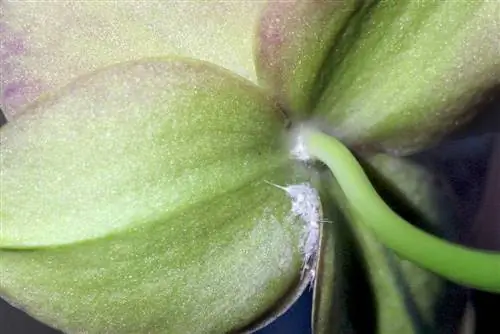
The female mealybugs can be found on almost all parts of plants. The first thing you usually notice is the cotton-like, white web that surrounds the mealybugs. This waxy, dense hair is intended to protect the mealybug from enemies and makes it resistant to the most extreme temperatures (down to -40 degrees). But there are also mealybugs that live underground on the roots. The lice also excrete honeydew, so that sooty mold fungi quickly settle on the affected plant. By sucking, mealybugs can potentially infect the plant with viral diseases.
Tip:
In contrast to scale insects, mealybugs prefer herbaceous plants such as daisies and legumes, but also citrus plants, orchids, cacti and other succulents.
Conclusion
While isolated pests in the garden are not dangerous, just annoying, this does not apply to infestations of houseplants. The plants should be checked regularly, especially in winter. Only a pest that is detected early can be combated quickly and effectively. Outside in the garden, it is usually only necessary to intervene in the event of a severe infestation before the pests completely destroy the well-kept ornamental or kitchen garden.
Tips for speed readers
- Early detection of an infestation is important for combating it
- It is also important that the pest is correctly identified
- Aphids: small, green or black insects on the undersides of leaves and shoot tips
- Black weevil: nocturnal, dark beetle, about 1 cm tall
- Caterpillars: feeding holes in the leaves, eaten leaves, holes in the cabbage
- Scale insects: difficult to detect, excrete honeydew
- Snails: nocturnal, eaten leaves or entire plant parts
- Spider mites: tiny insects in white webs
- Sad gnats: the larvae in the soil are harmful
- Whitefly: winged insects, about 2 mm long
- Mealybugs: usually recognizable by their cotton-like web

